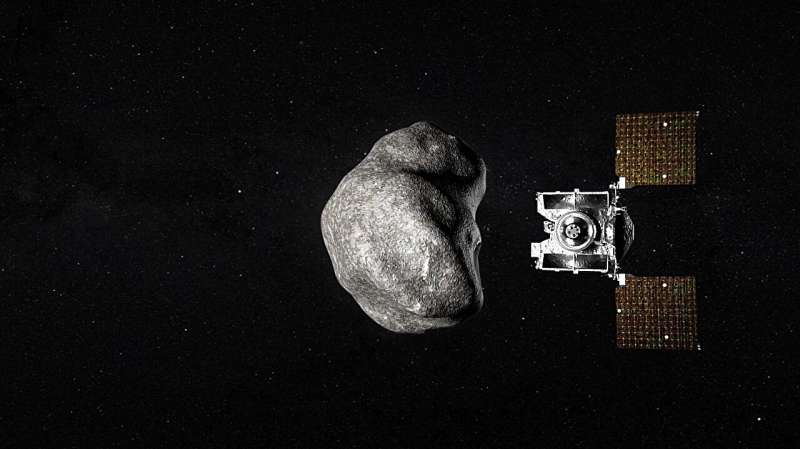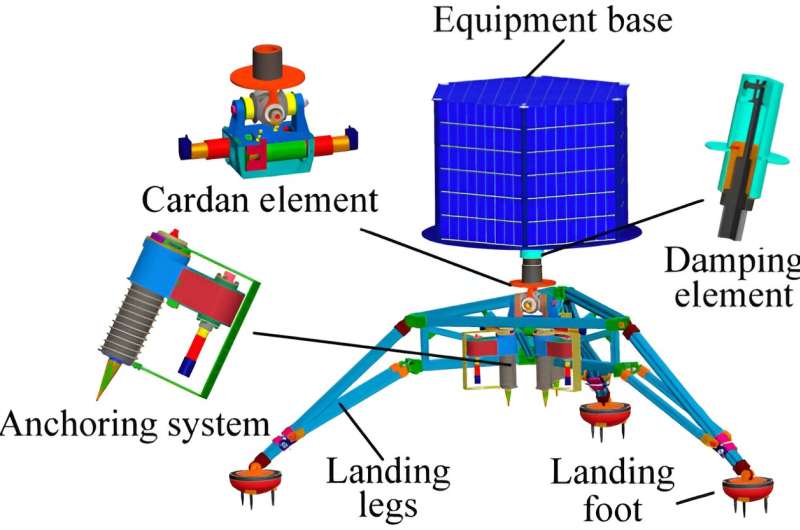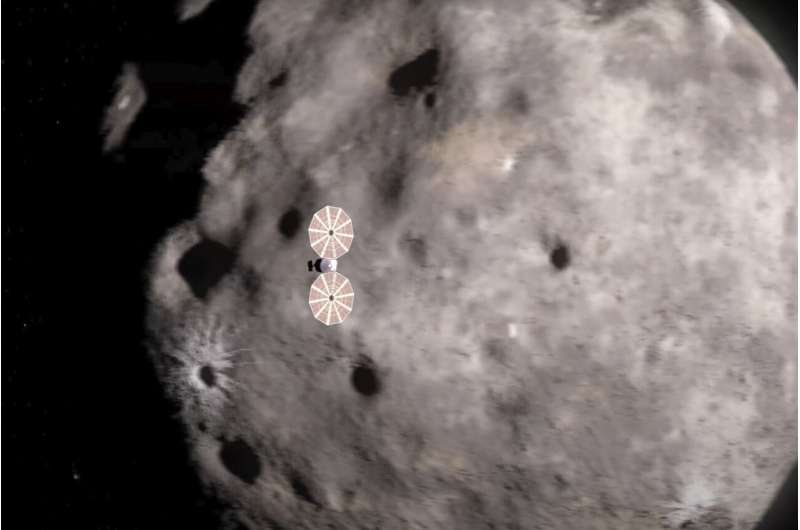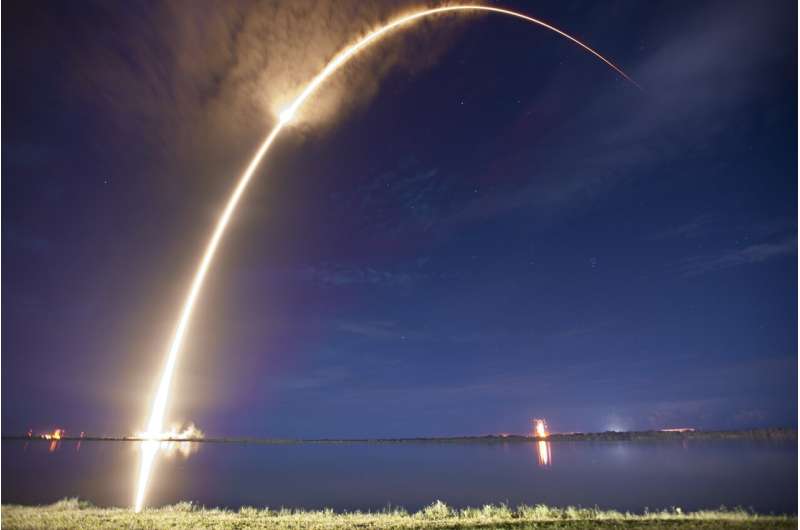
Copernical Team
OSIRIS-REx flies on as OSIRIS-APEX to explore its second asteroid

After seven years in space and over 4 billion miles traveled, NASA's OSIRIS-REx mission successfully collected and delivered the first U.S. sample from a near-Earth asteroid. Yet, after all this time and travel, the spacecraft will not retire.
Instead, NASA extended the University of Arizona-led mission so that the spacecraft can be used to study another near-Earth asteroid named Apophis. The mission was renamed OSIRIS-APEX, short for OSIRIS-APophis EXplorer. An overview of the mission was published in The Planetary Science Journal.
OSIRIS-REx deputy principal investigator Dani DellaGiustina is now the principal investigator for the OSIRIS-APEX mission.
Twenty minutes after dropping the sample high above Earth's atmosphere on Sept. 24, the spacecraft fired its thrusters to put it on course to rendezvous with Apophis in 5½ years—just after Apophis makes its own close approach to Earth.
Scientists develop a legged small celestial body landing mechanism for landing simulation and experimental test

Landing stably is a precondition for exploring a small celestial body in situ. The surface of a small celestial body frequently has weak gravity and is irregular, and the surface environment is unknown and uncertain. The landing mechanism tends to rebound and turn over, and the landing stability time is long. However, while most landing performance research has focused on lunar landing, there are differences between the surfaces of the moon and Mars.
Therefore, it important to study landing performance in different conditions in order to analyze the landing stability boundary, and to propose reasonable landing suggestions to support China's small celestial body exploration.
In a research article recently published in Space: Science & Technology, researchers from Beijing Institute of Spacecraft System Engineering, Harbin Institute of Technology, and Polytechnic University of Milan have established a simulation model of a landing mechanism under different landing conditions, analyzed the sensitivity of the key parameters affecting the landing performance, and verified correctness of the simulation via experimental tests, which can provide guidance for a landing mechanism to land stably on a small celestial body.
NASA's Lucy spacecraft swoops past first of 10 asteroids on long journey to Jupiter

NASA's Lucy spacecraft on Wednesday encountered the first of 10 asteroids on its long journey to Jupiter.
The spacecraft on Wednesday swooped past the pint-sized Dinkinesh, about 300 million miles (480 million kilometers) away in the main asteroid belt beyond Mars. It was "a quick hello," according to NASA, with the spacecraft zooming by at 10,000 mph (16,000 kph).
Lucy came within 270 miles (435 kilometers) of Dinkinesh, testing its instruments in a dry run for the bigger and more alluring asteroids ahead.
Space Force to split 21 launches between SpaceX, United Launch Alliance

The Space Force is giving a nearly even share of 21 upcoming national security launches between SpaceX and United Launch Alliance.
Space Systems Command, which manages a $15 billion budget for the Department of Defense to ensure U.S. strategic advantage in space, announced ULA will provide 11 missions on its new Vulcan Centaur rocket while SpaceX will be responsible for 10 missions on its Falcon 9 or Falcon Heavy rockets as part of the National Security Space Launch (NSSL) Phase 2 Launch Service Procurement contract for fiscal year 2024, which began on Oct. 1.
This is the fifth and final year of the NSSL Phase 2 contract, and will be for missions flown over the next two to three years. The majority of launches will come from ULA and SpaceX's launch facilities at Cape Canaveral Space Force Station, although Falcon Heavy launches if required are limited to Kennedy Space Center, and both ULA and SpaceX can launch from Vandenburg Space Force Base in California.
"Over the five-year Phase 2 contract, we will have ordered a total of 48 missions, a significant increase over the 34 missions originally estimated leading up to Phase 2," said Brig.
Chinese astronauts return to Earth with fruitful experimental results
 The Shenzhou XVI crew consisting of three Chinese astronauts returned to Earth safely on Tuesday, after completing a five-month space station mission.
Shenzhou XVI's return capsule, carrying astronauts Jing Haipeng, Zhu Yangzhu and Gui Haichao, touched down at the Dongfeng landing site in North China's Inner Mongolia autonomous region at 8:11 am (Beijing Time), and the crew had all left th
The Shenzhou XVI crew consisting of three Chinese astronauts returned to Earth safely on Tuesday, after completing a five-month space station mission.
Shenzhou XVI's return capsule, carrying astronauts Jing Haipeng, Zhu Yangzhu and Gui Haichao, touched down at the Dongfeng landing site in North China's Inner Mongolia autonomous region at 8:11 am (Beijing Time), and the crew had all left th Why the Roman Space Telescope will study the flickering lights of the Milky Way
 NASA's Nancy Grace Roman Space Telescope will provide one of the deepest-ever views into the heart of our Milky Way galaxy. The mission will monitor hundreds of millions of stars in search of tell-tale flickers that betray the presence of planets, distant stars, small icy objects that haunt the outskirts of our solar system, isolated black holes, and more. Roman will likely set a new record for
NASA's Nancy Grace Roman Space Telescope will provide one of the deepest-ever views into the heart of our Milky Way galaxy. The mission will monitor hundreds of millions of stars in search of tell-tale flickers that betray the presence of planets, distant stars, small icy objects that haunt the outskirts of our solar system, isolated black holes, and more. Roman will likely set a new record for Physicists embark on six-year hunt for dark matter particle
 In the pitch dark of the cosmos lurks an invisible kind of matter. Its presence is seen in the rippling ebb and flow of galaxies, but it's never been directly observed. What secrets lie beneath the surface, brewing in the deep?
Physicists have long theorized about the composition of dark matter, which is thought to be five times more abundant than regular matter. Among competing hypotheses
In the pitch dark of the cosmos lurks an invisible kind of matter. Its presence is seen in the rippling ebb and flow of galaxies, but it's never been directly observed. What secrets lie beneath the surface, brewing in the deep?
Physicists have long theorized about the composition of dark matter, which is thought to be five times more abundant than regular matter. Among competing hypotheses New jet stream discovered in Jupiter's upper atmosphere
 High-speed jet streams are a common feature in the atmospheres of many planets. On the Earth, jet streams form at various latitudes and meander around the planet, changing latitude and reaching speeds approaching 400 km/h at an altitude of over 10 km above the surface. On the giant planets Jupiter and Saturn, jet streams are one of the main features of the atmosphere; they are perfectly aligned
High-speed jet streams are a common feature in the atmospheres of many planets. On the Earth, jet streams form at various latitudes and meander around the planet, changing latitude and reaching speeds approaching 400 km/h at an altitude of over 10 km above the surface. On the giant planets Jupiter and Saturn, jet streams are one of the main features of the atmosphere; they are perfectly aligned Scientists discover molten layer covering Martian core
 NASA's InSight mission to Mars helped scientists map out Mars' internal structure, including the size and composition of its core, and provided general hints about its tumultuous formation.
But findings from a new paper published in the journal Nature could lead to reanalysis of that data. An international team of researchers discovered the presence of a molten silicate layer overlying Mar
NASA's InSight mission to Mars helped scientists map out Mars' internal structure, including the size and composition of its core, and provided general hints about its tumultuous formation.
But findings from a new paper published in the journal Nature could lead to reanalysis of that data. An international team of researchers discovered the presence of a molten silicate layer overlying Mar Daily Minor Planet volunteers spot an asteroid passing close to Earth
 Volunteers working with The Daily Minor Planet have made the project's first big discovery: an asteroid passing very near planet Earth. On the night of October 3rd, a telescope for the Catalina Sky Survey snapped four pictures of a far northern section of the sky. The next day, volunteers H. N. DiRuscio, X. Liao, V. Gonano and E. Chaghafi spotted a clear streak moving through each image and quic
Volunteers working with The Daily Minor Planet have made the project's first big discovery: an asteroid passing very near planet Earth. On the night of October 3rd, a telescope for the Catalina Sky Survey snapped four pictures of a far northern section of the sky. The next day, volunteers H. N. DiRuscio, X. Liao, V. Gonano and E. Chaghafi spotted a clear streak moving through each image and quic 